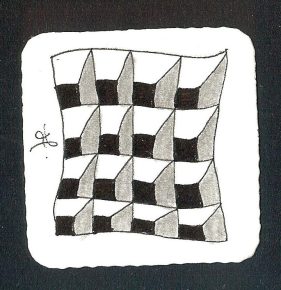Vermutlich habt ihr schon von diesem Buch gehört – wenn nicht ist es höchste Zeit! Eigentlich wollte ich eine andere Blogpost verfassen, dann habe ich gemerkt, ich muss zuerst ein paar Wörter über das neue Buch von Zentangle sagen.
Nachdem es unzählige „How-To“ Zentangle-Bücher auf dem Markt gibt, gibt es jetzt endlich eins von Rick Roberts und Maria Thomas, den Erfinder von Zentangle. Ihr erstes Buch „Book of Zentangle“ erklärt zwar auch die Methode, ist aber mehr eine Beschreibung und eine Geschichte als eine detaillierte, Schritt-für-Schritt Anleitung. Der „Primer“ ist da viel ausführlicher. Das englische Wort „Primer“ bedeutet (unter anderem) auch Lehrbuch, vor allem wenn es um Grundlegendes geht.
Das Buch ist nur auf Englisch erhältlich, aber wenn du zu den Zentangle-Begeisterten zählst sollst du das Buch unbedingt besorgen. (Kaufen kann man direkt bei Zentangle aber hoffentlich auch bis Ende Mai in Deutschland hier). Niemand schreibt treffender und schöner über Zentangle als Rick und Maria aber auch wenn man das wegen mangelnder Englischkenntnisse nicht wirklich würdigen kann, haben sie mit diesem Buch eine neue Idee in die Zentangle-Welt gesetzt, die man anhand von den Bildern und auch ohne viele Sprachkenntnisse begreifen kann: die „Reticula“ und die „Fragmente“. Glaubt mir, ihr werdet damit auch spielen wollen!
Rick und Maria lieben es, mit Sprache zu spielen und haben schon für die Zentangle-Methode einige Begriffe erfunden (wie z.B. „Zentangle“ 😉 …Aber auch „Kachel“, „Faden“ usw.). Es ist aber nicht nur ein Spiel. Genauso wie Zentangle-Kunst abstrakt ist, damit wir das Ergebnis nicht daran messen, wie gut etwas wiedergegeben ist und damit wir keine vorgefertigte Konzepte haben, wie es aussehen soll, unterstützen neue Begriffe uns darin, sie als was Neues zu sehen und für Möglichkeiten offen zu sein, die nicht in unseren vorgeprägtem Konzepten vorhanden sind. (An dieser Stelle danke ich Sabrina Stein, die mir dieses Aspekt erleuchtet hat.)
Also, was sind Reticula und was sind Fragmente? Fragmente sind Musterelemente, die man in verschiedenen Strukturen auf verschiedenen Arten und Weisen einsetzen kann. Und diese Strukturen – das sind die „Reticula“. Falls ihr jetzt völlig verwirrt seid helfen bestimmt ein paar Bilder weiter. Man nehme die bekannten Zentangle-Muster „Cubine“ und Bales. Sie kommen so zustande, dass man diese Musterelement (=Fragmente)
in dieser Struktur setzt (=Reticulum)
Mit folgenden Ergebnisse:
Im „Primer“ wird aber eine große Anzahl von verschiedenen „Fragmente“ gezeigt, und zwar nicht nur quadratisch sondern auch dreieckig und rund. Und als Reticula gibt es viel mehr Möglichkeiten als das übliche und bekannte Quadratraster. Und natürlich kann man seine eigenen Fragmente und Reticula entdecken und entwerfen – die Möglihkeiten sind unendlich. Ich habe zum Beispiel gemerkt, dass ein Muster von mir „Geschluckt“ hervorragend als „Reticula“ für runde „Fragmente“ funktioniert. Darüber schreibe ich in meiner nächsten Blogpost. Also wenn ihr neugierig seid, besorgt euch das Buch, es ist wirklich interessant und macht großen Spass. Ein Beispiel für eine Kachel mit Fragmenten aus dem Buch findet ihr HIER am Ende dieser Post.
You’ve probably already heard about the new book from Zentangle, the „Zentangle Primer Volume 1“. If not, then it’s high time!
Meanwhile, there is an endless number of Zentangle how-to books on the market, and so it is nice that the founders of Zentangle, Rick Roberts and Maria Thomas, have now also published one. Their first book, „The Book of Zentangle“ does contain complete information on the Zentangle Method as well as many beautiful pictures but it’s less of a detailed instruction book and more of a story about Zentangle itself. The „Primer“, true to it name, is a methodic and step-by-step introduction to the basics of the Zentangle Method and it is a must for all Zentangle enthusiasts. (You can order it here). It is full of helpful tips and ideas and no one writes about the Zentangle method more clearly than Rick and Maria. But, true to their boundless reserves of creativity, they also introduce a whole new idea to the Zentangle world, one you will not want to miss out on, and that is the idea of „reticulas“ and „fragments.“
Rick and Maria love to play with language and are good at coining terms – such as „Zentangle“ itself! But it’s not just a matter of playing with language. Just like Zentangle art is abstract so that we don’t judge the result by comparing it to some real thing it should look like, a new term helps us to see what is being described as something new and keep us open for possibilities that are not contained in concepts we believe we already know. (Thank you, Sabrina Stein, for helping me to get this!)
So what are reticula and fragments? Well, fragments could be described as pattern elements that can be used to fill in the spaces of various structures. The structures are reticula. Still confused? Well, a picture is worth a thousand words. You are probably familiar with the Zentangle patterns Bales and Cubine. These patterns can also be described in terms of fragments and reticula. The fragment is the basic element of the pattern:
And the reticula is the structure you fill with those elements, in this case a square grid:
Resulting in this:
This is just a quick example. In the „Primer“ Rick and Maria offer several pages of various fragments and also several pages of reticula to be filled with them. The fragments are not just square, but also triangular and round. And as for the reticula, they go way beyond that basic square gird! Once you’ve seen them, you begin to realize that the possibilities here are endless…and fun! You will want to make up your own. Here is a tile I did using some of the fragments in the Primer:






